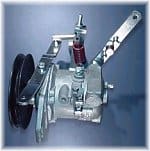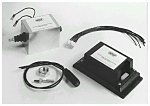Great tip discussing Governors on Industrial Engines
This Tech Tip, one of a series that we publish for both engine application engineers as well as fleet maintenance people, focuses on governors mounted on industrial engines. These governors are relatively simple devices that monitor, limit, and determine engine speed under various conditions. There are three main kinds of governors: velocity, mechanical and electrical.
Velocity governors
 Velocity governors are the simplest. They run on vacuum and mount between the carburetor and the intake manifold. They are compact (usually no more than an inch or so in thickness and only as wide as the carburetor’s mounting flange), easily installed, and adjusted with just a screwdriver. These governors just limit the maximum RPM an engine will run and so act as protective devices. Years ago they were commonly found on engines in taxi cab fleets. Today they are found on Chrysler Industrial LH 318 and Ford V8 industrial engines.
Velocity governors are the simplest. They run on vacuum and mount between the carburetor and the intake manifold. They are compact (usually no more than an inch or so in thickness and only as wide as the carburetor’s mounting flange), easily installed, and adjusted with just a screwdriver. These governors just limit the maximum RPM an engine will run and so act as protective devices. Years ago they were commonly found on engines in taxi cab fleets. Today they are found on Chrysler Industrial LH 318 and Ford V8 industrial engines.
Mechanical governors
Mechanical governors are more complex than velocity governors. There are three kinds of mechanical governors: belt-driven, gear-driven, and flyball weight-driven.
Belt drive governors
 Belt drive governors are often retrofitted to an engine where there wasn’t originally a governor. They mount on a bracket on the front of the engine and are driven by a belt between a pulley on the governor and the crankshaft pulley. Selecting the correct pulley size on the governor is important. Belt drive governors, like all mechanical governors, will not only limit top speed (as do velocity governors) they will also allow the engine to react while under a sudden load. Because of this they are found on wood chippers and other intermittent load applications.
Belt drive governors are often retrofitted to an engine where there wasn’t originally a governor. They mount on a bracket on the front of the engine and are driven by a belt between a pulley on the governor and the crankshaft pulley. Selecting the correct pulley size on the governor is important. Belt drive governors, like all mechanical governors, will not only limit top speed (as do velocity governors) they will also allow the engine to react while under a sudden load. Because of this they are found on wood chippers and other intermittent load applications.
Gear drive governors
Gear drive governors are installed by the engine manufacturer in the front timing gear cover and run off a timing gear. Some, as installed on industrial engines powering welding machines, may have a slot in their gear for a magneto to be installed. A common application in forklifts would be the Hyster Model P60 running a Continental F227 engine or the Hyster Model H50H running a Ford 172 engine. In both of the above examples, the governor is installed in the front gear cover with a large handle protruding up.
Flyball governors
Flyball governors are factory installed and are unique in our experience to Continental engines powering forklifts. These flyball governors are sometimes called “internal governors” to distinguish them from the more common mechanical governors that mount in the front timing gear cover on a bolt-on basis. These flyball governors are installed on the end of the camshaft in a pre-drilled pilot hole for the governor shaft. There is a race holding approximately a dozen ball bearings on the end of the shaft. When the engine speed is excessive, the flyballs are thrown to the outer edge of the race by centrifugal force. This then presses on an arm to limit overspeed. Typical applications would be the Hyster H80C powered by a Continental F245 engine.
Electronic governors
 Electronic governors. These governors typically are retrofitted to applications that now require a governor. They pick up the engine speed from the flywheel ring gear’s teeth and control it electronically.
Electronic governors. These governors typically are retrofitted to applications that now require a governor. They pick up the engine speed from the flywheel ring gear’s teeth and control it electronically.
We supply Hoof Governors as well as governors by Governors America Corp and would be happy to answer any questions.
This Tech Tip, one of a series that we publish for both engine application engineers as well as fleet maintenance people, focuses on governors mounted on industrial engines.




